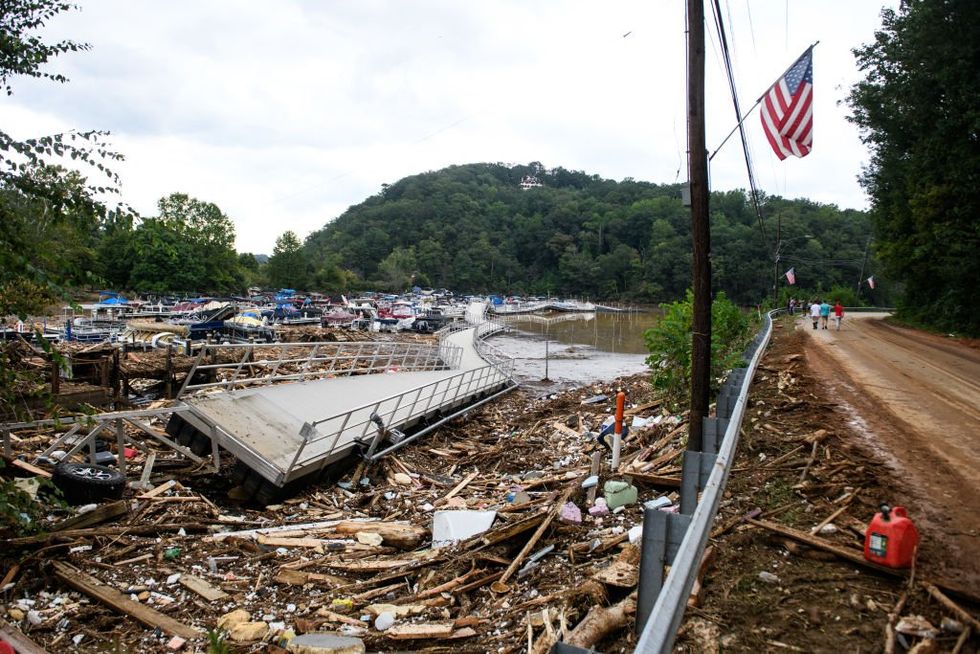The burning question after Hurricane Helene destroys southern Appalachia's forgotten communities
More than 100 Americans are dead after Hurricane Helene, a powerful Category 4 cyclone, made landfall in Florida last week. What made Helene unusual compared to previous major hurricanes is that communities hardest hit sit hundreds of miles from the coast. Dozens of people in Georgia and South Carolina are already confirmed dead, while at least 30 people in Buncombe County in North Carolina — where the city of Asheville is located — have already been confirmed dead. Where is the media coverage? Where are President Joe Biden and Vice President Kamala Harris? Unfortunately, the death toll is expected to rise as emergency crews finally reach impassable areas. The storm was especially devastating for mountain communities in north Georgia and the Carolinas because it had already been raining there for nearly a day — rain from a separate storm system — when Helene barreled through the region, bringing with her hurricane-force winds and torrential downpours. The cumulative impact caused mudslides and historic flooding while falling trees cut power to millions of Americans. Many of the Appalachian communities already forgotten were cut off from the outside world: no electricity, no running water, no internet, and no cell phone service. At one point, all four interstate entrances and exits into the city of Asheville were cut off. The flooding even wiped away entire communities. Interstate 40 near the Tennessee-North Carolina border is also impassable after one side of the highway fell into the raging Pigeon River. And dozens of people had to be rescued from a hospital roof in eastern Tennessee. A beautiful region of the United States has, in many areas, been permanently damaged. The impact is already being compared to what happened after Hurricane Katrina. Georgia Gov. Brian Kemp (R) described the destruction, saying it "looks like a bomb went off." North Carolina Gov. Roy Cooper (D), moreover, said Helene was "one of the worst storms in modern history." But there was a burning question on social media over the weekend: Where is the media coverage? Where are President Joe Biden and Vice President Kamala Harris? It's true the media is finally covering the story. But the problem that people expressed on social media over the weekend is that the coverage, especially on Friday and Saturday, did not match the magnitude of the unfolding disaster. — (@) As of Monday, the president and vice president have tweeted about the storm a handful of times combined. Additionally, Biden has approved "Major Disaster" declarations for Florida and North Carolina, and FEMA has deployed just 800 personnel to the region, according to CBS News. Harris also cut short a campaign trip to receive briefings on Helene.Meanwhile, Florida Gov. Ron DeSantis (R) is stepping up. Launching "Operation Blue Ridge," the Florida Republican deployed his state's resources to help with recovery efforts. Former President Donald Trump is scheduled to visit Georgia on Monday, where he will meet with local officials and help distribute disaster relief supplies. As rescue operations continue over the coming days and weeks, it will be difficult to comprehend the scope of the death and destruction. AccuWeather's preliminary estimate of total storm damage and economic loss is between $95–$110 billion. If you want to support recovery efforts, consider donating to Mercury One, Samaritan's Purse — which is located in Boone, North Carolina, a mountain town devastated by Helene — or other official charitable organizations assisting in the recovery. Like Blaze News? Bypass the censors, sign up for our newsletters, and get stories like this direct to your inbox. Sign up here!


More than 100 Americans are dead after Hurricane Helene, a powerful Category 4 cyclone, made landfall in Florida last week.
What made Helene unusual compared to previous major hurricanes is that communities hardest hit sit hundreds of miles from the coast. Dozens of people in Georgia and South Carolina are already confirmed dead, while at least 30 people in Buncombe County in North Carolina — where the city of Asheville is located — have already been confirmed dead.
Where is the media coverage? Where are President Joe Biden and Vice President Kamala Harris?
Unfortunately, the death toll is expected to rise as emergency crews finally reach impassable areas.
The storm was especially devastating for mountain communities in north Georgia and the Carolinas because it had already been raining there for nearly a day — rain from a separate storm system — when Helene barreled through the region, bringing with her hurricane-force winds and torrential downpours.
The cumulative impact caused mudslides and historic flooding while falling trees cut power to millions of Americans.
Many of the Appalachian communities already forgotten were cut off from the outside world: no electricity, no running water, no internet, and no cell phone service. At one point, all four interstate entrances and exits into the city of Asheville were cut off.
The flooding even wiped away entire communities.
Interstate 40 near the Tennessee-North Carolina border is also impassable after one side of the highway fell into the raging Pigeon River. And dozens of people had to be rescued from a hospital roof in eastern Tennessee.
A beautiful region of the United States has, in many areas, been permanently damaged. The impact is already being compared to what happened after Hurricane Katrina.
Georgia Gov. Brian Kemp (R) described the destruction, saying it "looks like a bomb went off." North Carolina Gov. Roy Cooper (D), moreover, said Helene was "one of the worst storms in modern history."
But there was a burning question on social media over the weekend: Where is the media coverage? Where are President Joe Biden and Vice President Kamala Harris?
It's true the media is finally covering the story. But the problem that people expressed on social media over the weekend is that the coverage, especially on Friday and Saturday, did not match the magnitude of the unfolding disaster.
— (@)
As of Monday, the president and vice president have tweeted about the storm a handful of times combined. Additionally, Biden has approved "Major Disaster" declarations for Florida and North Carolina, and FEMA has deployed just 800 personnel to the region, according to CBS News. Harris also cut short a campaign trip to receive briefings on Helene.
Meanwhile, Florida Gov. Ron DeSantis (R) is stepping up. Launching "Operation Blue Ridge," the Florida Republican deployed his state's resources to help with recovery efforts.
Former President Donald Trump is scheduled to visit Georgia on Monday, where he will meet with local officials and help distribute disaster relief supplies.
As rescue operations continue over the coming days and weeks, it will be difficult to comprehend the scope of the death and destruction. AccuWeather's preliminary estimate of total storm damage and economic loss is between $95–$110 billion.
If you want to support recovery efforts, consider donating to Mercury One, Samaritan's Purse — which is located in Boone, North Carolina, a mountain town devastated by Helene — or other official charitable organizations assisting in the recovery.
Like Blaze News? Bypass the censors, sign up for our newsletters, and get stories like this direct to your inbox. Sign up here!
Originally Published at Daily Wire, World Net Daily, or The Blaze
What's Your Reaction?





























































































